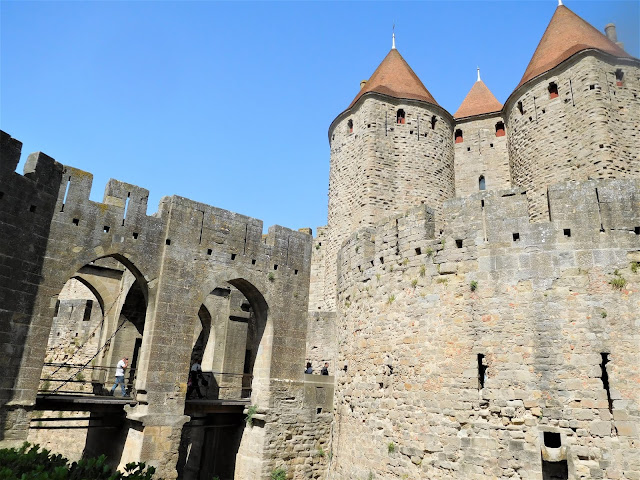 |
| The Moat was deeper than is seen today, but it didn't hold water |
The Citadel
of Carcassonne competes with Mont St. Michel and the Eiffel Tower for the most
visited site in France. In 1997, this citadel was placed on the UNESCO list as
a World Heritage Site.
The
fortification of the Medieval City of Carcassonne consists of two outer walls
and 53 towers and barbicans (an outer defense connected to a wall) to prevent
attack by siege devices. These walls or ramparts run nearly 2 miles around the
perimeter of the medieval city.
The towers were built during different time
periods. One section is Roman and is notably different from the medieval walls.
One of the towers housed the Catholic Inquisition in the 13th
century and is still known as “The Inquisition Tower.”
 |
| Town inside the Citadel |
First-time visitors to
the Citadel are often surprised to discover that a living town is located
inside its walls. Shops, cafes, and even 50 full-time residents live here.
The Romans
settled in Carcassonne during the 2nd Century before the Christian
era and initially set up an observation post and defense works. A colony of
Roman citizens settled around the fort.
The town spread over the centuries,
surrounding the fortification. After the fall of Rome, Carcassonne fell to the
Visigoths, who occupied the area for nearly 300 years from about 440 A.D. until
725 A.D. During this period, they restored the ramparts; but the Saracens
(Muslims from Spain) suddenly invaded the area in 725.
The Christian cause
triumphed and the Franks (Germanic tribes) became all powerful. The name France
(Francia) is derived from their name.
 |
| Cuts made on the bias for the archers to defend the Citadel |
After the
death of the Emperor Charlemagne and following the rapid disintegration of his
Empire, the representatives of the local government gradually became
independent. This was the beginning of the feudal period, during which the Counts and Viscounts of Carcassonne ruled without interruption for three
centuries.
This included the dynasty of the Trencavels, who lived in the Citadel. The Trencavels built the Basilica of Saints Nazarius inside the walled city.
 |
| The Donjon Room where important documents were signed and the lord's court sat for important occassions. |
This included the dynasty of the Trencavels, who lived in the Citadel. The Trencavels built the Basilica of Saints Nazarius inside the walled city.
The Basilica is known for its beautiful and intricate stained glass
windows. The Nave dates from the 11th and 12 centuries, and the
Gothic Transept and Choir dates from the 13th and 14th
centuries.
Commerce
flourished in the region, and it was through these exchanges during the 11th
century which led to the introduction of Catharism, or Albigensianism, which flourished between the 11th and 13th
centuries in and around Carcassonne.
The Catholic Church considered the Cathars to be heretics. The Cathars
refused all materiality in the sacraments and claimed that no event in this
world was due to the divine will. God reigned in the invisible world and the
material world was the work of Satan. The Roman papacy was concerned over the
growing strength of the Catharist church in the Languedoc region, where Rome
saw it as a threat to Christian unity. Thus, began the Albigensian Crusade, the
armed repression of the Catharist heretics.
 |
| Trap Door at the Entrance Gate for dropping rocks or other debris on the enemy |
The crusaders marched into Beziers
and slaughtered the Cathars, and then marched on Carcassonne on July 26, 1209.
In August, the Papal Legate forced its citizens to surrender. Viscount
Raymond-Roger Trencavel was imprisoned when he attempted to negotiate his
city’s surrender and died three months later in his own dungeon. Simon de
Montfort was appointed the new Viscount, who added to the fortifications of the
Citadel.
Around 1240,
St. Louis wanted to strengthen the Citadel, which was in the southern frontier
of his kingdom not far from Barcelona, Spain. His builders started constructing
the outer wall around the inner wall; however, it was Philip the Bold, son of
St. Louis, who from 1270 to 1285 gave the Citadel its full development and its
Royal Defense works.
 |
| The Bailey, the area between the Two Defensive Walls |
The defense works of the fortress were so formidable, that
the Black Prince, son of Edward III of England, was not able to penetrate the
Citadel.
Because
sentries had to stick their bodies half way out from the ramparts exposing themselves,
“hoardings” were used in the time of siege. Stout beams were placed in the
square holes at the level of the sentry-way.
At the end of the beams on the
outer side were fitted sloping beams connected together with planks. Flooring
was laid on top of the main beams, with a gap left in the planking, which
enabled the defenders to stand outside the battlements with a commanding view
of the base of the battlements, while being completely sheltered. Carcassonne
was the first fortress to use “hoardings” in time of siege.
 |
| Hoardings were used along the top of the sentry-ways |
The Pyrenean
Treaty of the 17th century destroyed Carcassonne’s strategic
importance by moving the frontier between France and Spain right up to the
Pyrenees. The inevitable decline of Carcassonne followed.
















No comments:
Post a Comment